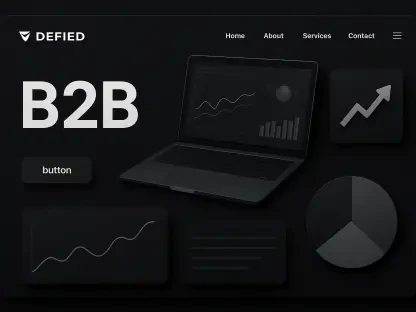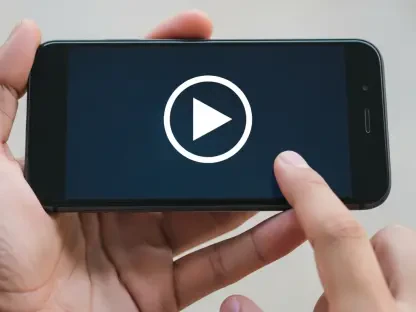In the evolving landscape of digital marketing, the debate between video content and traditional blogging continues to intensify as businesses strive to capture and retain audience attention. The efficacy of their content marketing strategies becomes paramount in this ever-competitive space. As search engines and platforms increasingly favor engaging and dynamic content, video content is emerging as a superior medium that offers a multitude of benefits over traditional blogs, especially in the realm of search engine optimization (SEO). This article explores why video content is outshining traditional blogging in SEO marketing, providing practical insights and strategies to leverage video to enhance engagement and conversion rates.
The Limitations of Traditional Blogging in SEO
Traditional blogging has long been a cornerstone of SEO marketing strategies, serving as a go-to method for driving organic traffic. However, it often encounters significant challenges in converting traffic into leads or customers. Many marketers overly rely on hope-based strategies, mistakenly assuming that readers will retain the content long after their initial engagement. This approach frequently results in high bounce rates as users typically skim through articles without fully digesting the intended message. Consequently, the potential for converting visitors into loyal customers diminishes significantly, undermining the marketing campaign’s overall success.
Moreover, the process of creating and maintaining high-quality blog content can be exceedingly time-consuming and mentally exhausting for subject matter experts (SMEs). Drafting, reviewing, and editing lengthy blogs require substantial effort, detracting from other critical business activities. This extensive workload can hinder SMEs from sharing their expertise consistently, leading to a drop in content quality over time. Despite these evident challenges, many businesses persist with traditional blogging, often overlooking the more dynamic and engaging alternatives available in the market.
Furthermore, traditional text-based content lacks the versatility and engagement metrics that videos offer. Text does not captivate audiences in the same way visual and auditory stimuli do, leading to shorter site visits and higher bounce rates. Users are often distracted and lose interest quickly when reading through lengthy articles, making it challenging to convey complex information effectively. Therefore, while blogs still play a role in SEO, their limitations in engagement and conversion are increasingly apparent, calling for a more innovative and efficient approach.
The Rise of Video Content in SEO Marketing
Video content is gaining prominence in the SEO marketing world, offering numerous advantages over traditional text-based methods. One of the most compelling benefits is the time efficiency it affords to SMEs. Recording a one-hour video can yield multiple articles while typically requiring less mental effort compared to drafting and reviewing written content. This increased efficiency allows businesses to produce more valuable content in less time, significantly enhancing overall productivity. The streamlined process also facilitates more frequent updates, keeping the audience engaged with fresh content regularly.
Additionally, video content tends to generate higher engagement and conversion rates. Visitors are more likely to engage deeply with videos, leading to actions such as subscribing to the creator’s channel and sharing the content with others. This increased interaction boosts organic reach through platforms like YouTube, where a single video can continue to attract viewers over an extended period. The ongoing engagement fosters a stronger connection with the audience, leading to higher retention and trust levels. Unlike text, which is often skimmed, videos encourage viewers to absorb the full message, resulting in better comprehension and more lasting impact.
Another significant advantage of video content is its ability to convey complex information far more effectively than text. Through visual and auditory cues, videos can break down complicated concepts into easily digestible segments, aiding in better understanding. This method caters to various learning styles and preferences, making the information more accessible to a broader audience. The emotional connection a viewer forms while watching a video can also be more profound than reading text, leading to a more memorable and impactful experience. Therefore, incorporating video into content marketing strategies can vastly improve the efficacy and reach of SEO efforts.
Enhancing Engagement Through Video Content
Embedding videos within blogs can significantly boost engagement and potential follower acquisition. When visitors encounter video content embedded in a blog, they are more likely to spend additional time on the site, exploring other available resources. This extended interaction not only improves engagement metrics but also enhances the likelihood of converting visitors into loyal customers. Videos make the content more digestible and interactive, encouraging users to stay longer and interact more with the site, which positively influences SEO rankings.
Platforms like YouTube play a crucial role in this process. Videos uploaded to YouTube have a higher chance of appearing on viewers’ ‘For you’ pages, facilitating continuous organic contact. This ongoing exposure helps in maintaining a relationship with the audience, encouraging repeat visits and sustained engagement. Utilizing YouTube’s extensive user base and recommendation algorithms can greatly amplify the reach of content, drawing in new visitors consistently. By leveraging the power of video content, businesses can create a more immersive and interactive experience for their audience, driving better results in their SEO marketing efforts.
Moreover, video content offers a unique opportunity for storytelling, which can be compellingly captured through visuals and sound. This method allows businesses to craft more relatable and engaging narratives, enhancing the connection with the audience. Interactive elements within videos, such as annotations or clickable links, can further drive engagement by directing viewers to additional content or taking specific actions. These features are not as easily incorporated into traditional text content, making videos a more versatile and engaging medium.
Furthermore, the use of live video streaming has also surged in popularity, providing real-time interaction opportunities with the audience. Platforms like Facebook Live, Instagram Live, and YouTube Live offer businesses the chance to engage with their audience instantaneously, answer questions, and provide immediate updates. Live interactions can feel more personal and authentic, fostering a stronger bond with viewers. By incorporating both pre-recorded and live video content into their marketing strategy, businesses can significantly enhance overall engagement and effectiveness.
Quantitative and Qualitative Evidence Supporting Video Content
The superiority of video content in SEO marketing is bolstered by both quantitative and qualitative evidence. Data consistently shows that users arriving via YouTube tend to have higher engagement durations compared to those coming from organic search. This heightened engagement substantiates the assertion that video consumers are more invested in the content they consume. Higher engagement rates lead to better retention and conversion rates, demonstrating the effectiveness of video content in creating meaningful and lasting interactions with the audience.
Anecdotal evidence further highlights the qualitative differences in customer interactions facilitated by video content. Videos enable a more personal connection with the audience, fostering trust and a pre-established relationship. This trust is crucial in converting visitors into customers, as they are more likely to engage with and purchase from a brand they feel connected to. The visible presence of a person in a video can convey emotions and authenticity much better than text, enhancing the viewer’s overall experience. This personal touch can make the brand more relatable, driving a deeper connection between the business and its audience.
Moreover, video content can significantly impact brand perception and credibility. High-quality videos demonstrate professionalism and attention to detail, which can positively influence the audience’s view of the brand. In contrast, poorly written or formatted blog posts might convey a lack of professionalism, potentially damaging the brand’s reputation. Videos also allow for showcasing products or services in action, providing a clearer understanding of their features and benefits. This visual demonstration can be more convincing than descriptive text, helping to drive conversions and sales.
Additionally, incorporating customer testimonials and case studies into video content can enhance credibility and trust. Seeing real customers share their experiences and satisfaction with a product or service can be more impactful than reading text-based testimonials. Videos can capture the nuances of customer satisfaction, including their tone and expressions, which can be compelling for prospective buyers. This combination of quantitative data and qualitative insights strongly supports the effectiveness of video content in SEO marketing, making it a crucial component of a successful digital strategy.
The Repurposing Potential of Video Content
One of the most significant advantages of video content is its repurposing potential, allowing businesses to extend its reach and impact across various platforms. A single video can be tailored and optimized for multiple platforms, such as LinkedIn, Instagram Reels, TikTok, and Facebook, each catering to different audience demographics and preferences. This versatility allows businesses to maximize the value of their video content, significantly enhancing their overall marketing efforts. However, it is essential to adapt the content appropriately for each platform to ensure maximum engagement and avoid potential backlash.
Effective repurposing requires a strategic approach, considering the unique preferences and behaviors of each platform’s audience. For instance, LinkedIn users might prefer professional, industry-focused content, while Instagram Reels and TikTok thrive on shorter, more entertaining clips. By tailoring the video content to suit each platform’s style and audience, businesses can ensure that their message resonates more effectively, driving better engagement and results. This adaptability not only saves time and resources but also broadens the reach of the content, tapping into diverse user bases.
Moreover, repurposing video content can help maintain a consistent brand presence across various digital channels. By consistently sharing valuable content in different formats, businesses can reinforce their messaging and maintain visibility among their audience. This approach helps in building brand recognition and loyalty, as users encounter the content on multiple platforms. Additionally, using different segments of the same video for varied content pieces can keep the audience engaged without the need for constant new content creation, streamlining the marketing process.
However, it’s crucial to maintain high-quality standards during the repurposing process to ensure the content remains coherent and engaging. Poorly adapted videos can lead to reduced engagement and potentially damage the brand’s image. Businesses should focus on creating original high-quality video content and strategically repurposing it across platforms, keeping in mind the distinct requirements of each channel. This approach maximizes the content’s potential while maintaining consistency and engagement.
Structuring a Video-First Content Marketing Funnel
Transitioning to a video-first approach in SEO content marketing involves creating a structured funnel that aligns traffic generation with conversion strategies. Unlike traditional text-based methods, which often rely on the memory of skim readers, video content ensures ongoing engagement and nurtures potential leads beyond the initial contact. A well-structured video-first funnel begins with creating high-quality, engaging videos that capture the audience’s attention and keep them engaged throughout the viewing experience.
These videos should be optimized for SEO, incorporating relevant keywords and metadata to enhance visibility and attract more organic traffic. Once the videos attract visitors, businesses can guide them through a series of targeted content, gradually moving them down the funnel towards conversion. This approach ensures a more cohesive and effective marketing strategy, driving better results at various stages of the funnel. Additionally, incorporating clear calls to action within the videos can prompt viewers to take specific steps, such as signing up for newsletters or making purchases, further enhancing the conversion process.
Furthermore, integrating video content across multiple stages of the customer journey can create a more personalized and engaging experience. From introductory brand videos to in-depth product demonstrations and customer testimonials, video content can address various needs and pain points of potential leads at different stages. This tailored approach helps in building a stronger connection with the audience, nurturing them through the funnel with relevant and engaging content. By providing valuable information and solutions through videos, businesses can effectively guide potential customers towards making informed decisions and ultimately converting them into loyal customers.
Incorporating analytics to track video performance is also essential in refining and optimizing the video-first content marketing funnel. By monitoring key metrics such as view duration, engagement rates, and conversion rates, businesses can gain valuable insights into the effectiveness of their video content. These insights can inform future content creation and marketing strategies, ensuring continuous improvement and better results over time. By leveraging the power of video content, businesses can create a more effective and engaging marketing funnel, driving higher engagement and conversion rates.
Conclusion
In the rapidly changing world of digital marketing, the discussion about the effectiveness of video content versus traditional blogging is becoming more intense as businesses aim to capture and keep audience interest. The success of their content marketing strategies is crucial in this highly competitive environment. With search engines and platforms increasingly prioritizing engaging and dynamic content, video is standing out as a superior medium, offering numerous advantages over traditional blogs, particularly in terms of search engine optimization (SEO). This article delves into the reasons why video content is surpassing traditional blogging in SEO marketing, providing practical tips and strategies to use video effectively to boost engagement and conversion rates.
In the modern digital landscape, visual content, especially videos, has a significant edge. Videos are not only more engaging but also more likely to be shared on social media, leading to higher traffic and better overall visibility. This increased engagement translates to improved SEO rankings, as search engines such as Google prioritize content that holds viewers’ attention. Furthermore, videos can convey complex information more effectively and in less time than text, catering to the fast-paced nature of today’s online audience. Integrating video into your marketing strategy can enhance user experience, increase retention, and ultimately drive more conversions.









